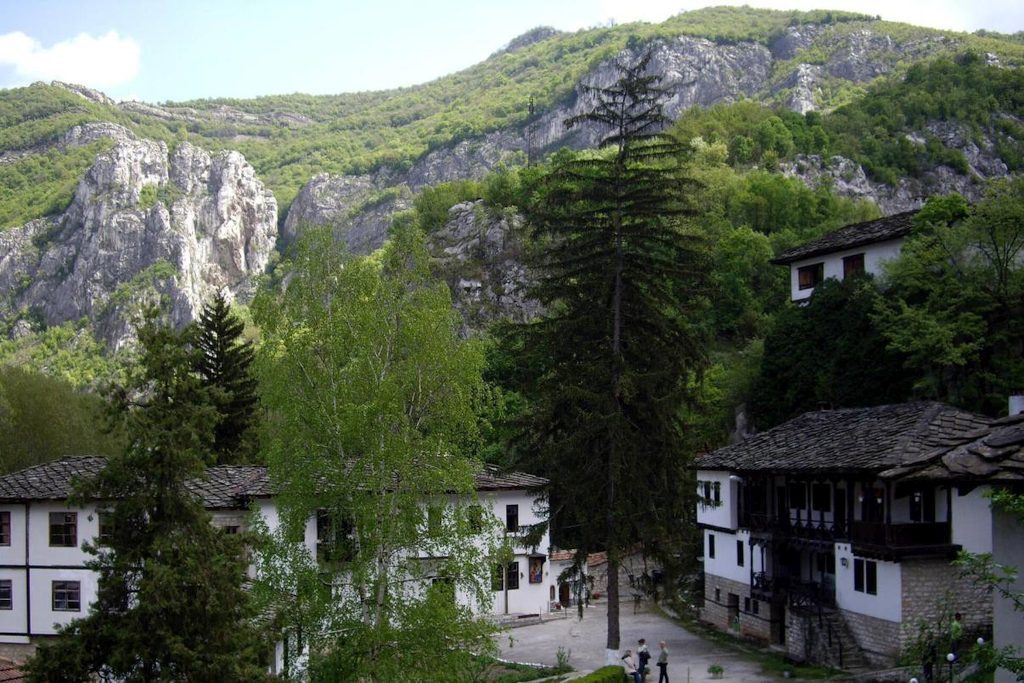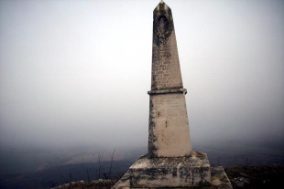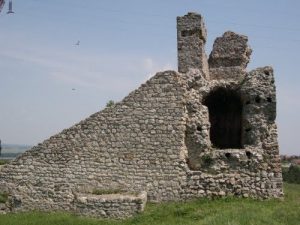

The Monastery Cherepish “the Assumption of Mary” is situated in the Quays Iskar, on the northern cliffs of the Balkan Mountains, on the river Iskar. The monastery is situated in the proximity of Liutibrod, at 10 km. from the city Mezdra and at 25 km south from the city Vrața.
Transportation:
Through Cherepish, the monastery is easily accessible with the car from Sofia, on the principal road (E79), in the city Mezdra, through the Quays Iskar. At approximately 5 km before Mezdra there is a by-pass which, after four kilometers, leads to the gates of the monastery. The monastery can be reached by train, taking it by foot at a station towards Liutibrod.
The monastery’s history
The apparition of the monastery Cherepish is connected to the medieval history of the “city Koriten”, which existed in the neighboring area from Ritlite”. According to the legend, the monastery received the name from the white bones of the warriors who fell after the battle which took place in the area of the king Shishman with the Turks. In the Archeology Museum from Sofia it is stored the Statute of the monastery, composed around the year 1396. There it is mentioned the fact that it was destroyed during the battle. In the 17th century, the monastery Cherepish was restored at the initiative of the famous Bulgarian artist Pimen Zografski. Later on, it was built up the current church. During the times of the Renaissance, the monastery is in course of development with a rich literature. It was also made a small school and there were written and copied books of the human life and gospels, such as – “The Gospel Cherpishkoto” from the 16th century, covered with gold and decorated with biblical scenes and the “Gospel according to Daniel” copied in 1616 by the monk Daniel and stored now in the church “Saint Nicholas” from Vratsa. Other works of the literature are Panegrik from the year 1623, “Apostle” from 1630, the work of the monarch James and a collection of preaches and teachings called “Margaret”, from the year 1732, composed by Todor from Vratsa.
The Monastery Cherepish grew gradually, in the first half of the 19th century, when there were built a few new buildings such as the bishop’s house, the former building of receiving the abbot, the house Rașidov, the school, the building Danailivata, the chapel with the charnel house, the tower of the church bell and others.
In 1798 – 1799 in the monastery Cherepish there was sheltered Saint Sofronie from Vratsa. Here is also founded the Revolution committee of the guardian of the monastery Epifanie. In the period 1872 – 1876, the monastery is visited by the commission and by the representative of BTSRK the revolution committee Vrața. In the proximity of the monastery there is the area Cherepish “Rashov”, in which there took place the last battle of Botev, commanded by Georgi Apostolov.
In 1889 and 1907, the monastery Cherepish was visited by Ivan Vazov and following the events which took place here it is developed his famous story “A Bulgarian”. In 1897, at the monastery arrived Aleko Konstantinov during his travel around these places, after which he have the name of his traveling novel the “Bulgarian Switzerland”.
After the 09th of September 1944, adjacent to the monastery Cherepish was moved at Sofia the Seminary “Sv. Ivan Rilski”, this came back at Sofia, after the 10th of November, 1989. At the seminary there activated the big church – “Saint Kliment Ohridski”, which is now abandoned.
The architecture and the current state:
In our days, the monastery Cherepish is lived by monks. The church dates the monastery back to the 17th century and it has a nave, massively arched with an apses. The dome of the church was built in 1888. But the today’s narthex dates back to 1939. At the beginning of the 19th century, the church was redecorated by Tryavna Y, the pope Vitanov and Vasil Iliev from Debar. By the boring it is discovered the fact that there were kept parts of the former mural painting, probably painted by Pimen Zografski in the 17th century, Among the tourism objectives we have the interior decoration of the church’s iconostasis with refined sculptures and embroidered canvas in 1844.
Most of the buildings from the monastery Cherpishkiya were built in the first half of the 19th century during the period of the Abbot Iosif. Later on there were built the so-called “building Rașidov”, the ”building Metodiu” and the “construction of Daniel”. In the year 1784, the monk Epifanie built the charbel house monastery in the rocks from above the monastery, with two floors. The chapel with the titular saint of “Saint John the Baptist” was consecrated on the 20th of August 1888 by the Bishop Konstantin Vratsa.
From the monastery Cherepish came one of the oldest manuscripts which survived in Bulgaria – the statute of the monastery written in 1390 – 1396. Today, this manuscript is kept in the former Church and the Archeology Museum from Sofia. In the monastery there were written and copied books and gospels. There should be mentioned as relics the Cherepish Gospel, the Gospel of the Monk Danail, the Book of collecting of the Apostles “Margaret”, Todor Vratsa and others. Of great interest is the silver tabernacle, executed in 1792 by the goldsmith Tosho and George.
Place of interest from the proximity:
In the proximity of the monastery there are found the natural components – the rocks Cherepish.



